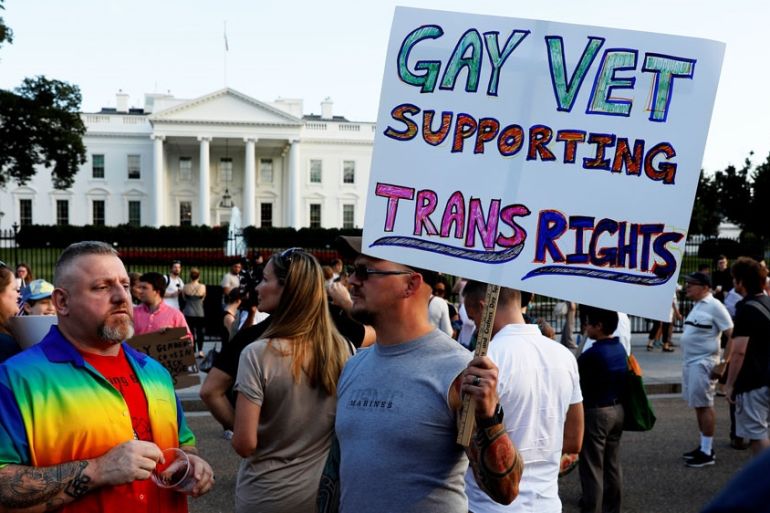Top US court lets military implement transgender restrictions
The Supreme Court on Tuesday reversed lower court orders preventing the Pentagon from implementing restrictions.

The US Supreme Court is allowing the Trump administration to go ahead with its plan to restrict military service by transgender people while court challenges continue.
The high court split 5-4 on Tuesday in allowing the plan to take effect, with the court’s five conservatives greenlighting it and its four liberal members saying they would not have.
Keep reading
list of 4 itemsIraq criminalises same-sex relationships with maximum 15 years in prison
In Australia, women-only app becomes latest front in war over trans rights
‘No good evidence’ for gender care for youth over long term, review finds
The Trump administration had urged the justices to take up cases about the plan directly, but the court declined for now. Those cases will continue to move through lower courts.
The lawsuits challenging the policy were filed in 2017 by civil liberties and gay and transgender rights groups on behalf of current transgender military service members, including some deployed overseas with decades of experience in the armed forces, and transgender people aspiring to join the military.
Until a few years ago service members could be discharged from the military for being transgender. That changed under former President Barack Obama. The military announced in 2016 that transgender individuals already serving in the military would be allowed to serve openly. And the military set July 1, 2017, as the date when transgender individuals would be allowed to enlist.
But after Trump took office, the administration delayed the enlistment date, saying the issue needed further study. While that study was ongoing, the president tweeted in late July 2017 that the government would not allow “Transgender individuals to serve in any capacity in the US Military”. He later directed the military to return to its policy before the Obama-era changes.
Revised policy
In March 2018, the Trump administration announced that, after studying the issue, it was revising its policy. The new policy generally bars transgender individuals from serving unless they serve “in their biological sex” and do not seek to undergo a gender transition.
The policy has an exception for transgender troops who relied on the Obama-era rules to begin the process of changing their gender, allowing them to continue to serve. The military said last year that over 900 men and women have done so.
The policy would also ban, under certain circumstances, transgender people who experience gender dysphoria, a condition the American Psychiatric Association defines as clinically significant distress due to “a conflict between a person’s physical or assigned gender” and the individual’s gender identity.
Federal courts had blocked the administration’s original policy, finding that it likely violated the US Constitution’s guarantee of equal protection under the law. Various injunctions allowed transgender troops to join the armed forces as of January 1, 2018.
The administration then failed to convince federal judges in Washington state, California and the District of Columbia that the revised policy was any more legally sound than the original ban as these judges found that the revised policy was merely an attempt to implement Trump’s original ban.
No longer a blanket ban
But Trump’s revised policy got a boost on January 4 when a federal appeals court in Washington, DC, sided with his administration and overturned the injunction issued by the judge there, saying the updated policy was no longer a blanket ban.
That ruling had a limited effect because other injunctions covering the whole nation remained in place.
Though another injunction issued by a judge in Maryland was not on appeal, the administration said in court papers the high court’s action would apply to that one, too.
In asking the Supreme Court to review the cases, the Justice Department said former Secretary of Defense James Mattis and other military leaders had determined that Obama’s policy “posed too great a risk to military effectiveness and lethality”.
The Supreme Court’s ruling on Tuesday lifted the preliminary injunctions.
The decision prompted criticism from proponents of transgender rights, such as the Southern Poverty Law Center (SPLC), an Alabama-based civil rights watchdog.
“Thousands upon thousands of transgender people have served and are serving this country with honor and courage,” the SPLC wrote on Twitter. “A ban only throws fuel on the fire of hatred and fear.”
Thousands upon thousands of transgender people have served and are serving this country with honor and courage. A ban only throws fuel on the fire of hatred and fear. #TransRightsAreHumanRights
— Southern Poverty Law Center (@splcenter) January 22, 2019
LGBTQ media advocacy group GLAAD said the ban creates a “dangerous environment for trans service members” and weakens “the strength of our military”.
With this ban, the Trump Administration created a dangerous environment for trans service members and are weakening the strength of our military and setting a dangerous precedent.https://t.co/AIX9ltCpzw
— GLAAD (@glaad) January 22, 2019
A 2016 Pentagon-commissioned study completed before Obama acted to allow transgender troops found that any impact on cost or military readiness would be marginal.
It estimated that there were around 2,450 transgender personnel actively serving in the military at the time.
Not all transgender people experience gender dysphoria, according to the American Psychiatric Association, which opposes a transgender military ban.
Mattis announced his resignation as Pentagon chief in December over other differences with Trump.